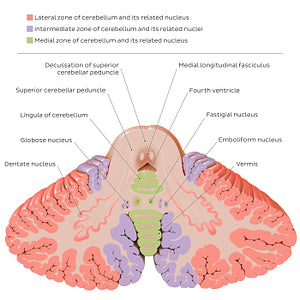Paul Kim
Cerebellar nuclei (English)
Cerebellar nuclei (English)
Section through the superior cerebellar peduncle and cerebellum, with the cortical regions color coded to match their target nuclei. The most medial nucleus is the fastigial nucleus (a.k.a. medial cerebellar nucleus), which lies with its contralateral fellow close to the midline. It is functionally related to the medial (a.k.a. vermal) zone of the overlying cerebellar cortex. Lateral to the fastigial nucleus are the emboliform and globose nuclei, which are alternatively referred to as the anterior and posterior interposed nuclei, respectively. These nuclei are functionally related to the intermediate (a.k.a. paravermal) zone of cerebellar cortex. The dentate nucleus (a.k.a. lateral cerebellar nucleus) is the largest and most expansive of the cerebellar nuclei; its size correlates to the large overlying lateral zone, to which it relates. It presents as an undulating layer of gray matter lateral to the interposed nuclei, which gives it a somewhat ‘crumpled’, flask-like appearance. Its opening, known as the hilum of dentate nucleus, is oriented anteromedially towards the superior cerebellar peduncle, to which its efferent fibers project. It can be further subdivided into dorsal motor/microgryic and ventral nonmotor/macrogyric parts which are said to play a major role in the modulation of voluntary movement as well as cognitive and visuospatial processes, respectively.
Normaler Preis
$7.56 USD
Normaler Preis
Verkaufspreis
$7.56 USD
Grundpreis
pro
Verfügbarkeit für Abholungen konnte nicht geladen werden


#D45738
#A96558
#632A1C
#3A2319
#FB897C und #BCA6D3

